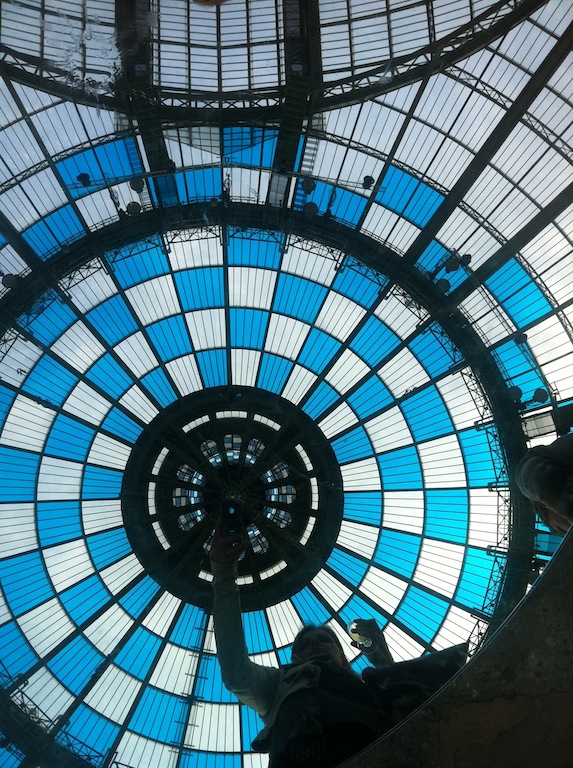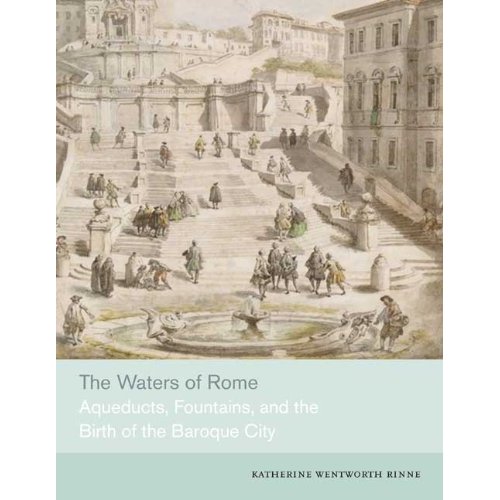Monumenta 2012: Daniel Buren, Excentrique(s)
Reviewed by Victoria Hobday

Monumenta 2012: Daniel Buren, Excentrique(s). Paris, Grand Palais, 10 May–21 June 2012.
Each year an artist of international stature is invited to create a work for the hugely successful Monumenta installation project in the Grand Palais in Paris. The Grand Palais is an enormous space 45 metres high and covering 13,500 square metres. Last year it was the turn of Anish Kapoor, who created Leviathan, an enormous inflated aubergine-coloured curved form that fully occupied the space. Its organic curves, suggesting some overgrown vegetable, contrasted with, while complementing, the greenhouse-like form of the Grand Palais (Figs. 1–4). Its interior came as a breathtaking surprise. After being ushered in through a revolving door one entered an intimate space, surrounded by the womb-like inversion of the outside shape and where light from the outside traced the architecture of the enclosing building (Figs. 2–3).
In 2010 Christian Boltanski employed a different approach that was equally successful in exploiting this vast interior. He created a work that engaged with the human condition in a sophisticated way: clothing was laid out carefully on the floor in squares, set between speakers that played the sound of recorded heartbeats (Figs. 5–6). Behind was a huge mound of clothing almost three storeys in height. A crane with a claw would descend and pick up a number of pieces of clothing, raising them to ceiling level before releasing them to flutter down to the pile below (Fig. 6). This element gave movement to the work and with it a sense of the randomness of fate in the selection of individual pieces of clothing that were picked up and dropped in a repeated cycle.
This year Daniel Buren was invited, and as a greatly revered French artist his installation was eagerly anticipated. Buren’s work in the past has engaged with the concept of ‘interventions’, and has been concerned with the environment in which an artist or a work operates both physically and socially. Buren often use striped surfaces to indicate the in situ works that he produced, his most famous being a large public commission in 1986 for the cour d’honneur in the Palais Royale in Paris called Deux Plateaux (Fig. 7). Because of his concern for the relationship between a work and the space it which it is situated, Daniel Buren seemed the perfect choice for year’s Monumenta. Unfortunately the work he produced does not live up to expectations.
Excentrique(s) is a vast interlinked construction of circles made of plexiglas in primary colours supported by thin striped poles that runs the length of the building (Figs. 8–9). Buren moved the entrance to the exhibition from the ‘dominating and controlling’ main entrance to a side entrance that he had created at one of the ends of the length of the space. (This was explained to us by one of the many guides placed around the exhibition for this purpose.) The idea is to undermine the nineteenth-century architect’s control over the audience and to allow the work to be seen at its greatest length. Unfortunately, the effect is underwhelming: it is like a vast but gaudy bus shelter. The transparent coloured circles probably looked good on paper, but in the space of the Grand Palais they obscure the setting, especially as the work is only about 2.5 m high and so sits just above the heads of the audience. It is as if someone has lowered the ceiling of the Great Hall of the National Gallery of Victoria to just above head height. While this establishes a domestic scale over a large area, it diminishes the grandeur of the enclosing structure.
Moreover, the centre of the work is muddled by the addition of four large circular mirrors on the floor that reflect blue panels on the glass of the building forty metres above that Buren has used to create his signature stripes (Fig. 10–11). There seems to be little connection between these two elements: the one seems to deny the volume of the space while the other draws attention to it. If these elements related to one another then it would make more sense, but instead they seem completely separate conceptually. Visible through the glass panels of the roof is a flag on top of the roof, which has been changed by Buren to one with stripes around a blank circle. But why? Evidently I missed the point; which makes it evident that it needs to be explained, as it lacks any visceral impact. The view is widely held amongst those I have spoken to who have seen the installation that Buren missed the opportunity to use the space in a dramatic and engaging manner. The work engaged neither with the audience nor the space. Perhaps the circles of coloured plexiglas for instance could have been repeated vertically, filling the height as well as the length of the building; or perhaps the panels could have been lit in such a way to generate reflections of the surrounding architecture. The introduction of other artists, musicians and dancers within the space serves to fracture even more what is a somewhat fragmented installation. It is a sad commentary on an installation when it is necessary to bring in entertainers to make it interesting.
Compared to the monolithic work of Anish Kapoor and the conceptually engaging work of Boltanski—or Buren’s earlier work—Excentrique(s) is a disappointment. The Monumenta project is immensely challenging for an artist, since a space as grandiose as the Grand Palais amplifies any weakness of conception of the single work that occupies it. Unfortunately, Buren has missed the mark.
© Victoria Hobday 2012
[Click on thumbnails to view larger versions]






Many thanks for this review (and images)…
I certainly don’t wish to dispute Victoria Hobday’s description and assessment of Buren’s work, nor her evident disappointment, especially not having seen or experienced “Excentrique(s)” for myself (or read other commentaries on the piece). I would, however, like to highlight some of the evaluative criteria suggested by the review – that this art work should overwhelm rather than underwhelm; that it should have a recognizable visceral impact; that in order to engage with its setting and audience the work should create a dramatic experience; it should call attention to, rather than obscure, the setting; it should enhance rather than diminish, the grandeur of the enclosing structure; that each element of the work, rather than suggesting contrasting ideas, should clearly relate to the others and so demonstrate the coherent, unified conception of the artist; and that the work should have no need of additional interpretive material…
Any of these claims are worth discussing further, perhaps for their reproduction of certain tropes to be found in the marketing of major public commissions of contemporary art, beyond the example of the annual “Monumenta” exhibition. They are especially worth reconsidering, however, in the context of a review that essentially argues that Buren’s work is unlike the previous two “Monumenta” commissions; that it is a fragmented work that interferes with the expected, established codes of movement and viewing behaviour within the Grand Palais, that it denies the volume of that space while also calling attention to it, and so fractures its grandiosity.
I’m curious whether such a description might equally well be used to indicate the success of “Excentrique(s)” in meeting Buren’s early career ambitions for his “works in progress”, of “not of fitting in more or less adequately with the game, nor even of contradicting it, but of abolishing its rules by playing with them, and playing another game, on another or the same ground, as a dissident” (Buren, 1977, Reboundings, Brussels: Daled & Gevaert, p. 73)?
Ruth: I always find it problematic when the failure of a work of art with respect to certain, or indeed any, evaluative criteria is presented as a criterion for its success. This is a strategy frequently adopted by artists to evade what their audience can reasonably expect: to have a set of criteria, implied or stated, by means of which they can decide whether they get anything out of the work. It is, in fact, the oldest strategy in the book: ‘Your painting is badly painted’. ‘Yes, this is because I am a dissident / I want to subvert expectations about painting / I want to show you I do not play by the rules’. But merely to assert this is banal. It is banal because absolutely anything the artist presents could be said to do this. It is only not banal if, implicitly or explicitly, it sets up a different set of rules that relate to this particular work. So, Ruth, in this case, what are the rules? What is (or might be) this ‘other game on the same ground’? If the work fails to succeed by the established Monumenta ‘rule’ or tradition that the work is a success insofar as it responds to this particular site, or by the other evaluative criteria that Victoria was prompted to apply by her experience of the work, in what way does it succeed?
I can see my comments might be interpreted in the way you suggest, David. (My personal pet annoyance is the representation of any controversy or critique of public art as a sufficient indicator of its worthiness!)
However I was initially prompted to respond with a comment to this review simply to suggest that there might be alternative ways for an artwork to “respond to site” than by inciting awed breathlessness in the viewer or a sense of grandeur. Indeed, I thought the review itself interestingly suggested different readings of how the artwork might be seen to respond (rather than fail to respond) to its location and context. (E.g. that it interrupts established codes of movement and viewing behaviour, that it denies the volume of that space while also calling attention to it, fracturing the impression of grandeur.)
I do think of Buren’s early work as intellectually interesting precisely because of the ways in which he attempted to not simply contradict or oppose artworld institutions and conventions, but to call attention to those conventions and (ideally) present alternatives ways of operating. (Apart from anything else, Buren’s work inevitably calls attention to his own position, functioning very much as an “insider” in relation to that artworld.) I’m not familiar with Buren’s more recent work and guess I am also just curious as to how the Monumenta commission sits (or not) in relation to that work…
anyhow, once again, thanks to Victoria and Melbourne Art Network for the stimulating review.
It is always brave to make comments on an exhibition you have not seen. I did see Buren’s installation at the Grand Palais during its last days and was fortunate enough to see Buren there perhaps admiring his work or at least observing the varied crowd present enjoying his efforts. On the basis of this experience I take issue with some aspects of Hobday’s review. For me there is limited value in making such direct comparisons, almost ratings, with the installations from other artists in previous years. Each should be judged on its own merits.
We were lucky enough to experience the work in the late afternoon on a day with passing clouds periodically blocking summer sunlight. This gave the work a vitality, depth and dynamism that enhanced it; certainly nothing of this felt like waiting on a bus stop. The most successful aspect of the work was Buren’s ability to use the whole ‘monumental’ volume of the available space with multiple smaller experiences that ranged from the intimate more individual or human, to the infinite space extending beyond the dome. No mean feat to pull off successfully in my opinion and something perhaps not fully acknowledged by Hobday. This was achieved by the various elements comprising Buren’s aesthetic whole, the scale, the range of the materials, the contrasts of the colours – the building blocks.
Can I say perhaps a Higgs boson experience?